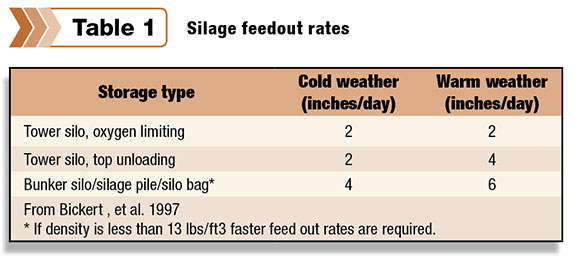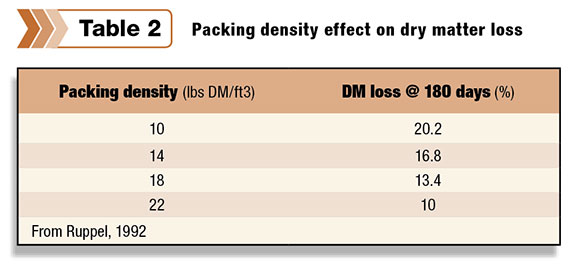This year producers may not have that luxury and may be already stretching their forages to get to harvest.
While little can be done now about last year’s shortages, it is a good time to sit down with your forage team and discuss getting everything you can from this year’s harvest.
The goal in forage making is to make consistent, good-quality forage. To keep the forage as consistent as possible the key is to plan ahead.
As the bunks and silos empty it is a good time to look at any maintenance that may need to be done before putting new forage in.
Check the silo roof and the silo/bunker walls for repair. Cracks in walls or around silo doors allow air into the storage space.
Rainfall on forage can trigger additional nutrient loss from seepage; make sure the silo roof is doing its job to keep rain out of the silo.
When planning on what bunks to fill, consider how the forage will be fed out. Feeding forage out of any storage system introduces oxygen to the forage and can increase dry matter losses.

Putting forage that will be fed out at a low rate into a large bunk or silo can increase forage losses at feedout due to spoilage.
Also keep in mind what time of year this forage will be fed, as that can impact your feed out rate. Table 1 suggests some minimum feed out rates.
This loss of forage from field to feed bunk is a costly problem on any farm. If supply is already limited it is especially important to reduce these “shrink” losses to get the most out of your fields.
According to Keith Bolson, Kansas State University, 20 percent of corn silage is lost each year to shrink. These shrink losses come from handling forage at harvest and feedout, from spoilage loss and from microbial deterioration.
Hay-crop forage losses can be even higher due to higher losses at harvest.
Harvesting crops at the correct moisture is not only important for producing a good-quality, consistent forage. Harvesting a crop too dry allows for lightweight particles to be lost at many stages along the way.
Cleaning up spilled forage and adding it to the forage mass at the end of each day minimizes this loss. Harvesting crops too wet allows for nutrients to be lost as forage juice seeps out.
This “juice” contains soluble carbohydrates and its loss lowers the energy and quality of the forage. Forages that are too wet may not ferment as well and may have problems such as clostridial fermentation.
Moisture at harvest also impacts how well the forage will pack into the silo or bunk. Forage that is too dry will not pack well and leave pockets of air.
The density of the forage in any storage system is essential to making quality forage. Packing forage to the correct density reduces the amount of air pockets in the forage mass and also prevents oxygen from penetrating the mass throughout the storage period.

Table 2 shows how dry matter loss is influenced by packing density. Packing forages for higher density also increases the amount of forage that will fit into a bunk or silo, reducing storage costs.
Even forage stored in silos should have the top surface leveled off and packed down.
One of the most time consuming chores after harvest is to cover the forage. It is also one of the most important ways to keep the forage from spoiling.
Keith Bolson has some tips for covering forage: seal the forage immediately after filling, use two sheets of polyethylene, overlap sheets by 3 to 4 feet, arrange the sheets so that water runoff doesn’t enter the forage mass, weigh the sheets down uniformly, monitor the sheets throughout the year and repair any damage.
It is also recommended that the area surrounding silos, bunkers and silo bags be kept cleaned and mowed to discourage rodents and other animals from disturbing the forage.
Shrink loss from microbial deterioration is hard to see even though 5 to 20 percent loss occurs before there are any visible signs such as molds.
If heating is occurring in the bunk or silo, forage dry matter and nutrients are being lost. Preventing oxygen from getting into the forage mass will help reduce microbial deterioration.
Ensuring a fast and effective fermentation can also reduce the amount of shrink loss. Using a silage additive is recommended by most forage experts to reduce dry matter losses during fermentation.
Good management of forage storage is the key to producing quality feed and reducing shrinkage loss.
The University of Wisconsin has a spreadsheet available online that allows producers to see how improving different areas of forage management can reduce the amount of money lost to shrink.
Before the harvest season arrives, sit down with your forage team and discuss different ways to improve forage management and set some goals for the coming season. FG 
Laura Martin
Kenpal Farm Products Inc.









